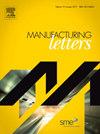Developing a hybrid-built pre-hardened alloy steel for injection moulding tools using the laser powder bed fusion process
IF 1.9
Q3 ENGINEERING, MANUFACTURING
引用次数: 0
Abstract
Hybrid additive-subtractive manufacturing has been adopted as a cost-effective alternative for manufacturing plastic injection moulding tools with conformal-cooled inserts created by fusing powder and wrought material. This article reports the development of a hybrid power-wrought pre-hardened alloy steel to supplement the current material choice for fabricating injection mould inserts using this advanced manufacturing strategy. In this study, MS1 (maraging 300) steel powder was additively deposited onto pre-machined wrought Nimax steel to form a hybrid alloy material. The mechanical and microstructural properties of the fusion-bonded interface were examined. Microstructural observation revealed a 280 m thick interfacial region consisting of a homogenous mixing of powder and substrate materials. As a result of solid solution strengthening within the region, tensile tests established robust powder-substrate bonding with tensile ruptures occurring well away from the interface. The as-built hybrid-alloy steel possessed excellent mechanical properties, with 1200 MPa in ultimate tensile strength, 12.4 % in elongation at fracture and 39 HRC (Nimax)/42 HRC (MS1) in hardness. The overall results suggested that hybrid MS1-wrought Nimax steel is a suitable pre-hardened material for manufacturing durable and high-performance injection mould inserts as part of a cost-effective hybrid additive-subtractive manufacturing strategy.
利用激光粉末床熔融工艺开发用于注塑模具的混合型预硬合金钢
增材-减材混合制造技术已被作为一种具有成本效益的替代方法,用于制造塑料注塑模具,其保形冷却镶件是通过熔融粉末和锻造材料制成的。本文报告了混合动力锻造预硬合金钢的开发情况,以补充当前使用这种先进制造策略制造注塑模具镶件的材料选择。在这项研究中,MS1(马氏体时效 300)钢粉通过添加剂沉积到预加工的锻造 Nimax 钢上,形成了一种混合合金材料。研究人员考察了熔融结合界面的机械和微观结构特性。微观结构观察显示,粉末和基体材料均匀混合后形成了 280 μm 厚的界面区域。由于该区域内的固溶强化,拉伸试验确定了粉末与基体之间的牢固粘结,拉伸断裂发生在远离界面的地方。制成的混合合金钢具有优异的机械性能,极限抗拉强度为 1200 兆帕,断裂伸长率为 12.4%,硬度为 39 HRC(Nimax)/42 HRC(MS1)。总体结果表明,MS1-锻造混合 Nimax 钢是一种合适的预硬化材料,可用于制造耐用的高性能注塑模具镶件,是具有成本效益的增材-减材混合制造策略的一部分。
本文章由计算机程序翻译,如有差异,请以英文原文为准。
求助全文
约1分钟内获得全文
求助全文
来源期刊

Manufacturing Letters
Engineering-Industrial and Manufacturing Engineering
CiteScore
4.20
自引率
5.10%
发文量
192
审稿时长
60 days
 求助内容:
求助内容: 应助结果提醒方式:
应助结果提醒方式:


